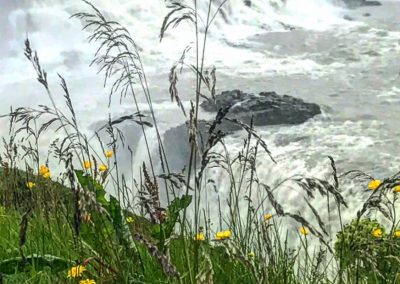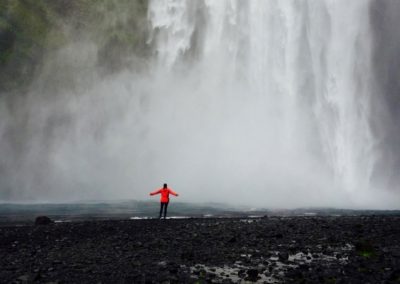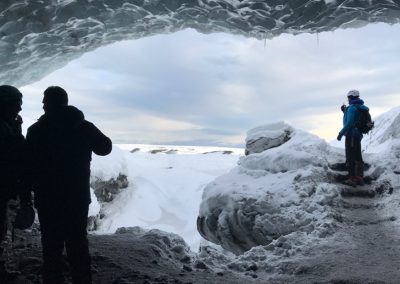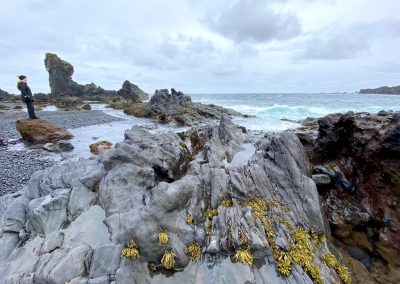7 Day – Around Iceland Tour
Tour duration
7 days
Availability
All year
Pick-up
8:30 – 9:00 AM
Difficulty
Easy
Included
- Pickup at your accommodation
- Around Iceland Sightseeing
- Professional Local Guide
- Hotel or guesthouse accommodation (private bathroom)
- Breakfast on day 2 -7
- Lunch on day 1
- Free WiFi
- Drop-off at your accommodation
What to bring
- This is a multi-day tour and you should bring your luggage with you
- Bring warm and waterproof clothes
- Gloves and headwear and good shoes
- A camera is always good to have
- Swimsuit and towel (can be rented at location)
Tour highlights
Djúpivogur
7 Day Around Iceland Adventure
Join us on this amazing 7 day Around Iceland Adventure visiting all the amazing places around the island. We start by exploring the Golden Circle, visiting Thingvellir National Park, Geysir Hot Springs, Gullfoss Waterfall, a rare lunch experiene at the unique Friðheimar Greenhouse restaurant and unwind in the warm and cosy Secret Lagoon. After breakfast on day 2 we head to the South Coast and enjoying the 60 metres high (196 ft) Seljalandsfoss Waterfall from behind. A small trail takes you around the waterfall giving you an unique view from behind the waterfall. The majestic Skógafoss Waterfall is the next visit. Learn about warming climate and the effect on glaciers in Iceland by visiting the Sólheimajökull glacier. Reynisfjara Black Beach and Reynisdrangar await to be explored, but watch out for those sneaky waves, they can be very strong. Stop at Vík village before heading to the accommodation. After breakfast on day 3 start by visiting Fjarðrágljúfur Canyon and Skaftafell National Park and hike to the beautiful Svartifoss Waterfall. Jökulsárlón Glacier Lagoon is a 200 metre (656 ft) deep glacial lake fed by Breiðamerkurjökull Glacier, an outlet glacier from the largest glacier in Europe, Vatnajökull. Enjoy the floating icebergs and perhaps seals swim by. Fjallsárlón is another Glacier Lagoon that you will have the opportunity to enjoy. Diamond Beach, the black beach in front of Jökulsárlón Glacier Lagoon, is often filled with icebergs from the lagoon of different sizes and shapes and sparkle like diamonds in the daylight. In winter (November – March) explore the crystal Blue Ice Caves. From Höfn head towards Mývatn and visit the highlights of East Iceland. Dettifoss waterfall is the largest and most powerful waterfall in Iceland, quite magnificent. After breakfast on day 5 visit one of the most beautiful location in Iceland, the Mývatn area. Mývatn Lake is an active volcanic area with frequent earthquakes, beautiful volcanic wonders and the lake itself attracts many species of migrating birds in the summer. Dimmuborgir is a very unique area, of dramatic rock formations, big lava pillars, lava rocs and volcanic caves. Námaskarð is one of the most beautiful landscapes in Iceland, with constantly changing patterns of boiling mud pools and mud pots, fumaroles and hot springs. Visit Krafla volcano and caldera before unwinding in the beautiful Mývatn Jarðböð Spa. Enjoy free time in Akureyri in the evening. After breakfast drive the Snæfellsnes Pensinula and visit all the beautiful locations it has to offer. Snæfellsnes Peninsula is sometimes referred as Iceland in a nutshell, for its variety of nature attractions. On the way back to Reykjavík stop at the charming Borgarnes village.
Tour Program
DAY 1
9:00 AM – REYKJAVÍK TO GOLDEN CIRCLE
Pick up between 8:30 – 9:00 AM, at your accommodation, or meet us at bus stop number 8, next to Hallgrímskirkja church. Wait for the Travelling Iceland vehicle.
THINGVELLIR NATIONAL PARK & ÖXARÁRFOSS WATERFALL
Thingvellir is characterized by tectonic rift valley and marks the rifting of the Eurasian and North American plates from each other. In 930 the Icelandic Parliament, the first democracy in the world, was established at Thingvellir. Thingvellir became a UNESCO World Heritage Site in 2004. Enjoy a short walk to Öxarárfoss waterfall.
STROKKUR & THE GEYSER AREA
Did you know that the english name “geyser”, derives from the one and only in the Haukadalur area? The geyser Geysir itself erupts boiling water up to 70 meters, but is almost inactive now. Strokkur, only few meters apart from Geyser, erupts on average every 5 minutes.
GULLFOSS, GOLDEN WATERFALL
Near Geysir is the Gullfoss Waterfall, which probably tops the list of being the most beautiful waterfall in Iceland. Enjoy the view from above and walk down the path to get close to the powerful waterfall.
FRIÐHEIMAR GREENHOUSE FARM AND HORSE VISIT.
At Friðheimar greenhouse, tomatoes are cultivated, using geothermal heat and geothermallly generated electricity. With a tropical climate inside, they have opened a restaurant, right there in the tomato field. The main ingredients in their menu is of course, tomatoes grown there. This is a very rare and unique lunch experience. On the way we visit some friendly Icelandic horses.
SECRET LAGOON
Secret Lagoon is a natural geothermal bath, where you bath in raw nature and relax at the end of the day.
NORTHERN LIGHTS IN WINTER
Between August 25 and April 25 we will hunt for the northern lights. Overnight near Hvolsvöllur.
DAY 2
9:00 AM – SOUTH COAST
SELJALANDSFOSS & GLJÚFRABÚI WATERFALLS
After breakfast visit Seljalandsfoss, beautifully located where a path takes you around the waterfall and standing behind it is a rare and unique experience. However, on very cold days the path can be closed because of ice, but then you have the opportunity to enjoy the beautiful icy landscape. Gljúfrabúi is a nearby waterfall. Gljúfrabúi translates to “the one who lives in the canyon” and is a small hidden waterfall partially obscured by the cliff rock. You need to follow a trail along the small river to enter the narrow canyon where the waterfall tumbles down.
SKÓGAFOSS WATERFALL
Skógafoss is one of the most famous waterfalls in Iceland. It is also 60 m high and about 25 m wide. Seljalandsfoss and Skógafoss are both in glacier rivers, meltwater from Eyjafjallajökull and Mýrdalsjökull. Eyjafjallajökull is now famous for it’s 2010 volcanic eruption that disrupted air traffic in Europe.
SÓLHEIMAJÖKULL GLACIER
Learn about warming climate and the effect on glaciers in Iceland by visiting the Sólheimajökull glacier. Sólheimajökull is an outlet glacier, flowing out of the ice cap Mýrdalsjökull. Underneath Mýrdalsjökull is the famous volcano Katla. Glaciers are retreating and disappearing around us on an unprecedented rate. It is predicted that in a few decades the glaciers in Iceland will all be gone.
DYRHÓLAEY (summer)
At Dyrhólaey there is an amazing view of the south coast landscape and black beaches. Dyrhólaey is a 120-metre high promontory that the sea has eroded from the headland. In summer Dyrhólaey is rich in bird life, the most common, the puffin. Note, in spring during nesting Dyrhólaey is closed.
REYNISDRANGAR AND REYNISFJARA BLACK BEACH
Iceland is a volcanic island, made up mainly of basaltic material that is black in colour. Hence, the “Black Beaches”. The black beach was, in 1991, ranked as one of the ten most beautiful non-tropical beaches in the world. On the beach, there are remarkable basalt columns. Reynisdrangar is a sea stack, a geological formation made by wave erosion of surrounding material.
EYJAFJALLAJÖKULL VOLCANO
Hopefully the weather allows a view of Eyjafjallajökull volcano, which is famous for it´s eruption in 2010, that disrupted air traffic in Europe.
VÍK VILLAGE
Vík village is a small village south of Mýrdalsjökull glacier. A visit to Vík is the end of our amazing day along the South Coast. Overnight near Kirkjubaejarklaustur.
DAY 3
After breakfast drive to Skaftafell National Park. Skaftafell belongs now to a larger, Vatnajökull National Park, which covers Vatnajökull, the largest glacier in Europe, and the surrounding wilderness. In Skaftafell we hike to the beautiful Svartifoss, in English, the Black Waterfall. Svartifoss cascades about 20 m (65 ft) down a beautiful cliff, made of hexagonal black basalt columns.
Fjallsárlón is another beautiful glacier lagoon, in front of a calving glacier. The glacier is an outlet glacier from Vatnajökull that flows down a steep valley until it reaches the lagoon. Ice breaks off the glacier and floats around in the water, creating a beautiful scenery.
In winter we visit natural ice caves but in summer when they are closed we enjoy an amazing glacier hike and in Skaftafell we hike to the beautiful Svartifoss, in English, the Black Waterfall. Svartifoss tumbles down 20 metres (65 ft) from a cliff that is made of beautifully hanging hexagonal basalt columns. The hexagonal columns form inside a lava flow that cools extremely slowly, giving rise to crystallization.
Winter: Natural ice caves in winter (November – April) (min age 10).
Overnight near Höfn.
DAY 4
After breakfast drive from Djupivogur towards Egilsstaðir. Djúpivogur is very picturesque fishing village, and known for its art and beautiful views. Drive past the East Fjords to Egilsstaðir.
On our way to Egilsstaðir, we will visit Hengifoss and Litlanesfoss waterfalls. Hengifoss waterfall is one of the highest waterfalls in Iceland, located in a beautiful geological setting. Litlanesfoss is surrounded by beautiful basalt columns.
We arrive in Egilsstaðir and head to our lodging, where you will find yourself surrounded by mountains, nature and silence.
DAY 5
Dettifoss waterfall is the largest waterfall in Iceland and the most powerful in Iceland and Europe. It falls about 100 meters down to Jökulsárgljúfur canyon.
After breakfast visit Lake Mývatn. Mývatn is one of the largest lakes in Iceland, home to many migrating birds in the summer. Skútustaðagígar are beaufitul pseudocraters at the southwestern corner of the lake.
Námaskarð, often referred to Hverarönd is an active and ever changing field of thermal springs, mud pots and boiling mud. The geothermal activity brings to the surface bubbling mud pools and steaming ground and colorful fumaroles and solfataras. The beautiful colours are due to sulphur and white and yellowish brown sulphates are deposited.
Few kilometres to the north of Námaskarð, is Krafla, the central volcano.
Dimmuborgir, an amazing geological wonder, is composed of massive lava tubes, up to few meters in diameter. They were formed about 2.300 years ago, when the lava flowed over a small lake. The water started to boil and the vapour rose through the lava forming these massive lava tubes. Dimmuborgir is the home to the icelandic jule lads.
Jarðböð spa, is naturally heated man-made lagoon, with mineral-rich waters known for their health-giving properties.
DAY 6
9:00 AM – WEST ICELAND
On our way to Akureyri we stop by the amazing Goðafoss, „Waterfall of the Gods“. Goðafoss is one of the most beautiful waterfalls in Iceland. The name derives from the year 1000 when the lawspeaker Þorgeir Ljósvetningagoði made Christianity the official religion of Iceland. When Þorgeir returned home from the Parliament Alþingi, he supposedly threw his statues of the Norse gods into the waterfall, symbolizing the shift in Iceland´s official religion.
Arrive in Akureyri. City tour and drive towards Snæfellsnes Peninsula.
KIRKJUFELL AND KIRKJUFELL WATERFALL
After breakfast head west to Snæfellsnes Peninsula. Kirkjufell Mountain and Kirkjufell Waterfall are the first stops. Kirkjufell, located on the northern side of the Snæfellsnes Peninsula, is one of the most picturesque mountains in Iceland, and with the Kirkjufell waterfall in the vicinity makes a wonderful nature stop. Kirkjufell was chosen to be one of the filming locations for Game of Thrones, featuring as the “Arrowhead Mountain”.
DJÚPALÓNSSANDUR BLACK BEACH
Djúpalónssandur black beach is a bay at the tip of Snæfellsnes Peninsula. The black small pebbles on the beach have been smoothed by the ocean waves, and amongst them are scattered rusty parts of a wreckage of a ship that stranded in the area in 1948. In the old days, fishermen used to test their strength by lifting heavy rocks, that still lie there. Heaviest is Fullsterkur (“full strength”), weighing 154 kg, next is Hálfsterkur (“half strength”) weighing 100 kg, hálfdrættingur (“weakling”) weighing 54 kg and Amlóði (“Useless”) 23 kg. They were traditionally used to qualify men for work on fishing boats, with the Hálfdrættingur being the minimum weight a man would have to lift onto a ledge at hip-height to qualify.
LÓNDRANGAR CLIFFS
Lóndrangar cliffs are rock peaks that have formed by erosion of the surrounding material. Lóndrangar is volcanic plugs of basalt, at 75 and 61 meters in height.
DAY 7
ARNARSTAPI VILLAGE
Arnarstapi is a small fishing village on the southern side of Snæfellsnes Peninsula. It is known for its sculpture of Bárðr, who was a half human and half ogre. His mother was human, but his father was half giant and half troll. Bárðr, his wife and his daughters emigrated to Iceland and came to shore in Djúpalón. Bárðr and his family lived in the area and the legend says that after losing his daughter, he gave away his land and vanished into the Snæfellsjökull ice cap. He became the “guardian spirit” of the Snæfellsnes area and was worshipped by the locals in many years to come.
VATNSHELLIR LAVA CAVE
Vatnshellir lava cave is a lava tube in an 8000-year lava field. The lava was formed in an eruption in a nearby crater Purkhólar. During the eruption the lava flowed downhill, cooling down on the surface while still running below, ultimately draining out and leaving a beautiful lava tube, which is now accessible. Overnight on the Snæfellsnes Peninsula.
We stop in the small village, on our way to Reykjavík.























